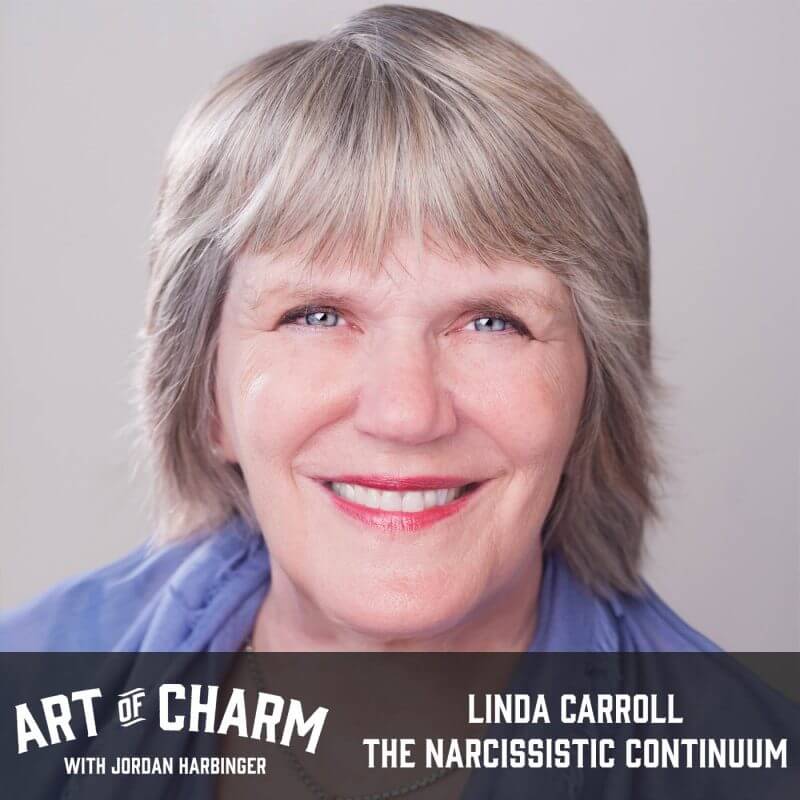Linda Carroll (@Lovecycleslinda) rejoins the show to discuss how we often label the other person in a relationship as “the crazy one” and why we need to examine where we land on the narcissistic continuum. Linda is a therapist and author of Love Cycles: The Five Essential Stages of Lasting Love.
The Cheat Sheet:
- After a painful breakup, have you ever casually referred to the estranged party as your “crazy ex?”
- It’s common to chalk up the strains of complex human dynamics as the results of someone else’s mental disorder when we want to avoid taking personal responsibility for them — and this is dangerous.
- While a real narcissist is hard to find, we all land somewhere on the narcissistic continuum.
- Learn what we can do if we think we or someone we know and love might be in a relationship with a narcissist — or even be one.
- Understand the difference between being a true narcissist and exhibiting narcissistic qualities.
- And so much more…
[aoc-subscribe]
When we’re looking back on a relationship that’s failed — or one that’s about to — it’s easy to label the other person in that relationship as somehow disordered on a psychiatric level. The “crazy ex” is a stereotype that’s probably been around as long as lost love itself.
But what might we discover if we examined a relationship’s failure not by playing into this stereotype, but by seeing where we ourselves fit on the narcissistic continuum — a scale that applies to all of us? Love Cycles: The Five Essential Stages of Lasting Love author and therapist Linda Carroll rejoins the show to help us avoid playing the blame game and better understand the factors that strain a relationship. Learn and enjoy!
More About This Show
Whenever she comes to the show, therapist and Love Cycles: The Five Essential Stages of Lasting Love author Linda Carroll always gives us lots to think about — and this, her third visit, is no exception. In this episode, she addresses an alarming trend she’s noticed that builds upon the “crazy ex” stereotype while simultaneously (and incorrectly) absolving half the people in any relationship.
“I started hearing people talking about people in their life who were difficult,” says Linda. “‘My mother’s a borderline personality.’ ‘My ex-girlfriend’s a sociopath.’ ‘My boyfriend’s a narcissist.’ I got curious about this because it seemed like it was happening all the time. People were using these labels…and I know that, from my own clinical studies, maybe one percent of the population are real, live narcissists…I couldn’t believe how many blogs I read, many by people who are not trained or had not studied psychology, [that would say things like]: ‘If…your girlfriend says this, she’s a narcissist; dump her.'”
It’s easy to see how this epidemic of unqualified misdiagnoses can cast a shadow over accurately understanding the complexities of human interaction. Explaining away the ex after a tragic breakup as being “crazy” isn’t a new phenomenon, but being so specific about it — without the academic credentials to make such an assessment — seems to be. So as someone who does have the credentials, Linda’s trying to clarify some of the most common misperceptions she’s been encountering — especially regarding narcissism.
At one percent, only a hundred people in ten thousand qualify as true narcissists. But according to Linda, we all fall somewhere along the spectrum she calls the narcissistic continuum. “Some people are real, live narcissists, but they can adapt and they can develop their empathy,” she says. “Other people at the other end, which is sociopathology, they can’t. But out of that one percent, there are many people that can adapt to life and love.”
It can be said that healthy narcissism is what keeps us aware of our own sense of well-being and instills the self-esteem essential to mingle with others without succumbing to the crushing doubts of insecurity. “Healthy narcissism is what gives us resiliency — the sense that we’re entitled to a good life or to love,” says Linda. “So if you think of that continuum, of healthy narcissism on one end and unhealthy narcissism on another end, and that everybody has it — narcissism is something that we all are a part of…[and that’s] different from a personality disorder.”
Contrast this concept with someone who has a clinically verified narcissistic character disorder — someone who really does believe that everything revolves around them and has an inability to understand that other people matter — and you begin to see why the distinctions matter.
Listen to this episode of The Art of Charm in its entirety to learn more about how modern western culture seems to stimulate latent narcissistic tendencies, the personality types that narcissistic people attract, the reasons that narcissistic/codependent relationships eventually fall apart, the differences between the grandiose narcissist and the vulnerable narcissist, why pathologizing normal behavior under stress is dangerous, why narcissists are the loneliest of people, and lots more.
THANKS, LINDA CARROLL!
If you enjoyed this session with Linda Carroll, let her know by clicking on the link below and sending her a quick shout out at Twitter:
Click here to thank Linda Carroll at Twitter!
Resources from this episode:
- Linda’s previous appearances on AoC: Love Cycles (Episode 480) and Lasting Love (Episode 512)
- Love Cycles: The Five Essential Stages of Lasting Love by Linda Carroll
- Is Your Ex REALLY a Narcissist? by Linda Carroll (via mindbodygreen)
- Linda Carroll’s website
- Linda Carroll at Twitter
You’ll also like:
- The Art of Charm Challenge (click here or text 38470 in the US)
- The Art of Charm Bootcamps
- Best of The Art of Charm Podcast
- The Art of Charm Toolbox
On your phone? Click here to write us a well-deserved iTunes review and help us outrank the riffraff!
